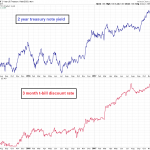The official word from China, in the sense that whispers and unofficial back channels counts for any kind of imprimatur, was that last week’s huge surge in offshore yuan money rates was at the request of the PBOC using state banks to squeeze those damned speculators. It was perhaps an usual step to take in that the PBOC’s major efforts are almost always hidden and intentionally suppressed; this was very public and open. That suggested that either the PBOC was back once more, like August, with little other option or that something else was going on.
There has always been a reverential deference in the media with regard to the PBOC’s believed abilities. It wasn’t all that long ago that “devaluation” in the yuan was taken as intentional vigor under the PBOC’s order clearing out “hot money.” That proved far too charitable an interpretation as the events of 2015 leave little doubt that those events in early 2014 were an early warning they were going to lose control. So it was with HIBOR rates last week, where the O/N rate at 66% even if deliberate in ridding the offshore market of speculators still reeked of despondency in breaking silence.
New data from the PBOC’s balance sheet suggests that it may not have been so much aimed at speculators as preserving forex availability (and why physical dollars may be so short in China). For all the confusion that typically accompanies central bank and monetary accounting, the PBOC is relatively simple. There are assets, primarily of forex “securities”, which drive the growth rate (or contraction) in liabilities which count for money. The major forms of such money or liquidity are physical cash and bank reserves (called “Deposits of Other Depository Corporations”).
As noted here a month ago (subscription required), the adjustments in November were quite stark and telling. Total foreign assets declined by RMB256 billion, RMB316 billion in terms of forex securities (and whatever derivative assets count in this unspecified pile). That decline was partially offset by a RMB153 billion increase in the asset line “Claims on Other Depository Institutions”, which is the liquidity and term liquidity loans under the SLF to primarily the large state owned banks like China Development Bank. With some other more minor changes on the asset side, total assets for the PBOC “only” declined by about RMB100 billion. From that we should expect a similar magnitude reduction in primarily bank “reserves” on the “Deposits of Other Depository Corporations” line.














Leave A Comment